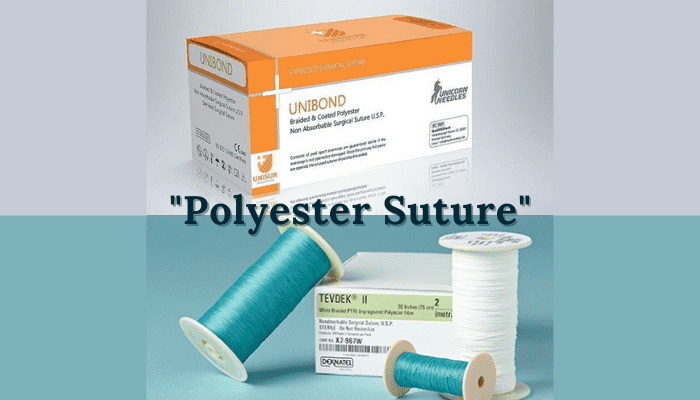Composition
Polyester suture is synthetic braided multifilament, strong, nonabsorbable suture derived from ethyleneglycol and terephthalic acid (poly ethylene terephthalate – PET). Polyester is a multifilament braided suture material available in plain and coated forms. The coatings comprise of silicone (primarily)/ Teflon/polyethylene, and outer coating causes lubrication of fibers. Tevdek Braided Polyester suture by Teleflex medical OEM comprises heavy PTFE (polytetrafluoroethylene) coating which reduces the dead space in the braid and makes it virtually inert, and lowers the risk of wicking and tissue reactivity. Polyester suture is ethylene oxide / gamma rays sterilized and spools can be easily sterilized by autoclaving.
Tensile Strength
It has high/excellent tensile strength and is half strong than cotton. The fibers are soft, pliable, wrinkle proof and retain tensile strength indefinitely when implanted. Except for metallic sutures polyester is considered to be the strongest non-absorbable suture material.
Absorption
Polyester sutures are non-absorbable in nature. They are not subjected to degradation and retain tensile strength indefinitely in vivo. And sutures gradually encapsulated by the fibrous connective tissue. It can potentiate existing infection. Individual polyester fibers are hydrophobic in nature.
Fig: Unibond – Polyester Suture by universal sutures
Knot Security
The coating reduces tissue drag but slightly decreases knot security. Usually, it has good knotting strength and knot placement is smooth. The uncoated polyester suture has poor knot security, high coefficient of friction and high tissue reactivity limit its use in surgery.
Tissue Reaction
Uncoated polyester suture has significant tissue drag. Polyester incites mild to moderate tissue reaction (grade 2). Tissue reaction is usually acute. Tissue reaction is more with uncoated polyester suture.
Indications
It is primarily being used in general closure/soft tissue or skin approximation, cardiovascular procedures, ophthalmic procedures, plastic surgery, neurological procedures, orthopedic procedures, tendon and ligament repairs (extracapsular cruciate ligament repairs) because of its excellent tensile strength. It has been largely replaced by monofilament sutures. They are excellent choice for cardiovascular and ophthalmic surgeries (retinal surgery, orbit and oculoplasty).
Contraindications
Polyester sutures are not recommended for biliary and urinary tract surgeries.
Its use is contraindicated in case of known hypersensitivity to silicone or polyester and in the infected/contaminated wounds. It may harbor bacteria within braid which may lead to persistent infection and chronic draining tracts and potentiates. Skin sutures should be removed within 30 days of implantation depending on the wound condition.
Color & Sizes
They are usually dyed green/black/blue for enhanced visibility. It is also available in white color (undyed).
The sizes are 5 to 9-0 in different brands with different lengths, non needled or attached to stainless steel needles of varying types, sizes and shapes.
Teleflex Medical OEM offers wide range of USP gauze sizes of braided polyester sutures –
1. Non-sterile Tevdek polyester suture material spools (heavy PTFE coated) i.e. Green: 9 through 9-0 suture, white: 9 through 9-0 suture, Green/white multi-colored: 2 through 4-0 suture
2. Sterile Tevdek Suture (heavy PTFE coated) i.e. Green: 9 through 7-0 suture, White: 9 through 7-0 suture, Green/white multi-colored: 2 through 4-0 suture
Fig: Tevdek II – Non-sterile Polyester Suture Spools (Heavy PTFE Coated) Dyed and Undyed
Fig: Silky II Polydek Polyester Suture (Light PTFE Coated) – Sterile and non-sterile spool
3. Non-Sterile Polydek Suture (light PTFE coated) i.e. Green: 9 through 9-0 suture. White: 9 through 9-0 suture. Green/white multi-colored: 2 through 4-0 suture
4. Sterile Polydek Suture (light PTFE Coated) i.e. Green: 9 through 7-0 suture. White: 9 through 7-0 suture. Green/white multi-colored: 2 through 4-0 suture.
5. Non-Sterile Cottony II Suture spools (Uncoated) i.e. Green: 9 through 9-0 suture; 1, 2, 3, 4, and 5mm tape. White: 9 through 9-0 suture; 1, 2, 3, 4, and 5mm tape. Green/white multi-colored: 2 through 4-0 suture.
6. Sterile Cottony II Suture (uncoated) i.e. Green: 9 through 7-0 suture; 1, 2, 3, 4, and 5mm tape. White: 9 through 7-0 suture; 1, 2, 3, 4, and 5mm tape. Green/white multi-colored: 2 through 4-0 suture.
Fig: Cottony II Suture (Braided) – Uncoated Polyester Suture (mechanically softened as smooth as cotton)
Storage
Should be stored in dry conditions at 10oC-35°C and normal suture handling guidelines must be followed. Reuse or re-sterilization should be avoided. Shelf life is up to 5 years.
Examples
Ethibond excel polyester suture by Ethicon, tevdek braided polyester suture, procare – polyester suture by dolphin sutures, Unibond by universal sutures, Covidien Ticron Sutures
Fig: Ethibond excel polyester suture by Ethicon
FAQs
Polyester sutures are synthetic nonabsorbable braided suture (coated – silicone/PTFE) composed of Polyethylene terephthalate (PET) fiber. It is primarily being used in general closure/soft tissue or skin approximation, cardiovascular procedures, ophthalmic procedures, plastic surgery, neurological procedures, orthopedic procedures, tendon and ligament repairs (extracapsular cruciate ligament repairs) because of its excellent tensile strength.
No. Polyester sutures are non-absorbable in nature. They are not degraded in vivo and retain tensile strength for indefinite period (later get encapsulated with fibrous connective tissue.
